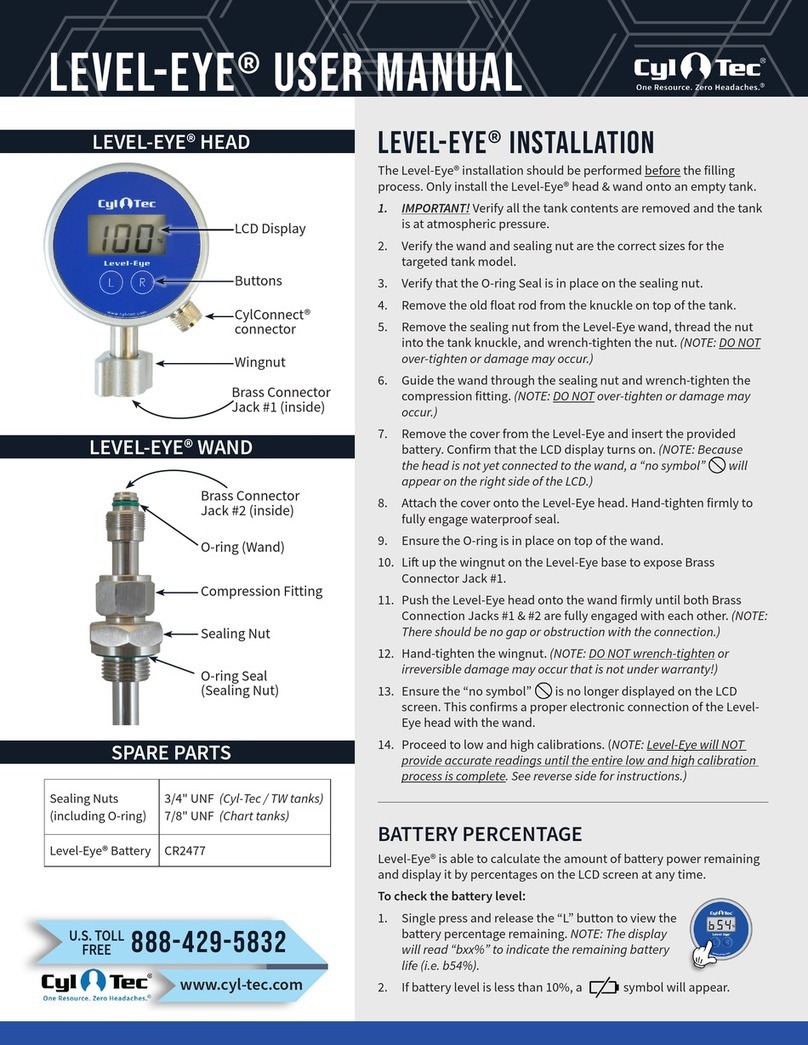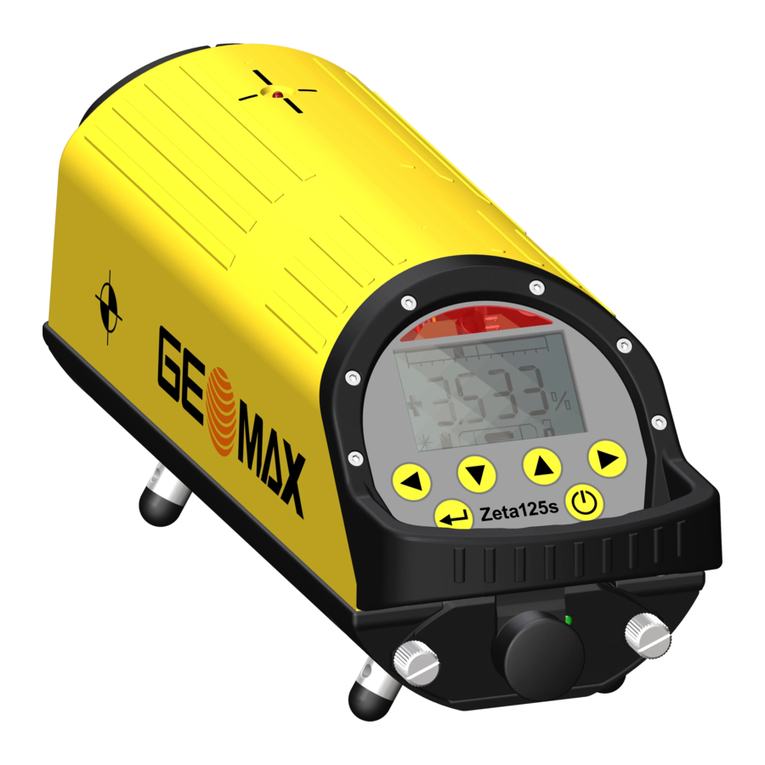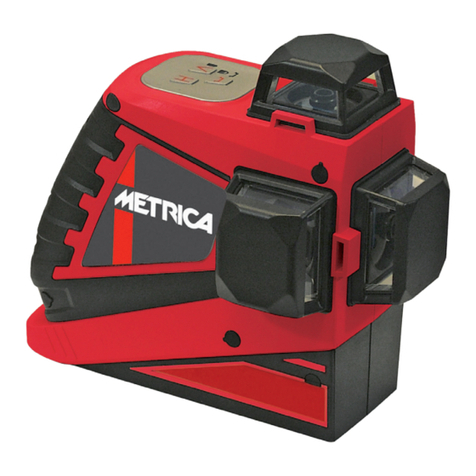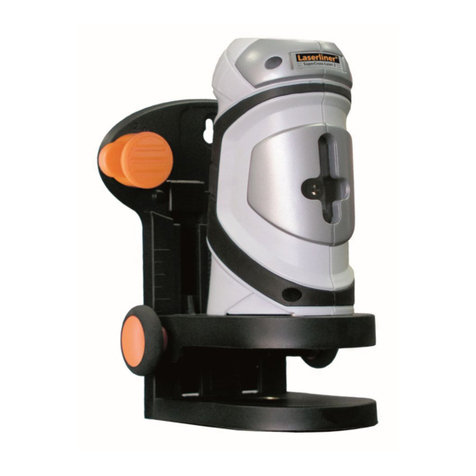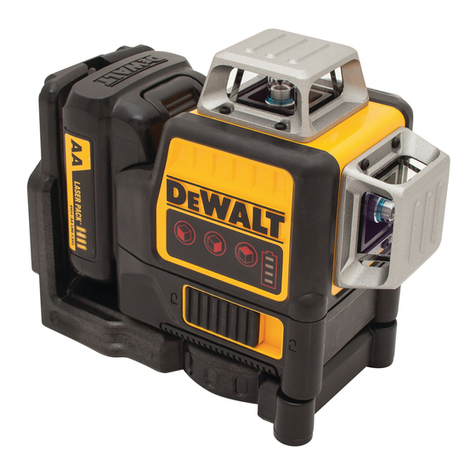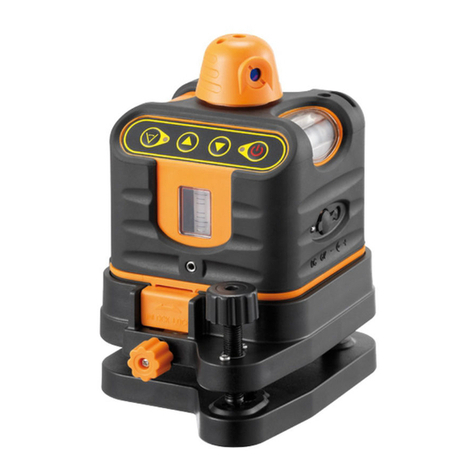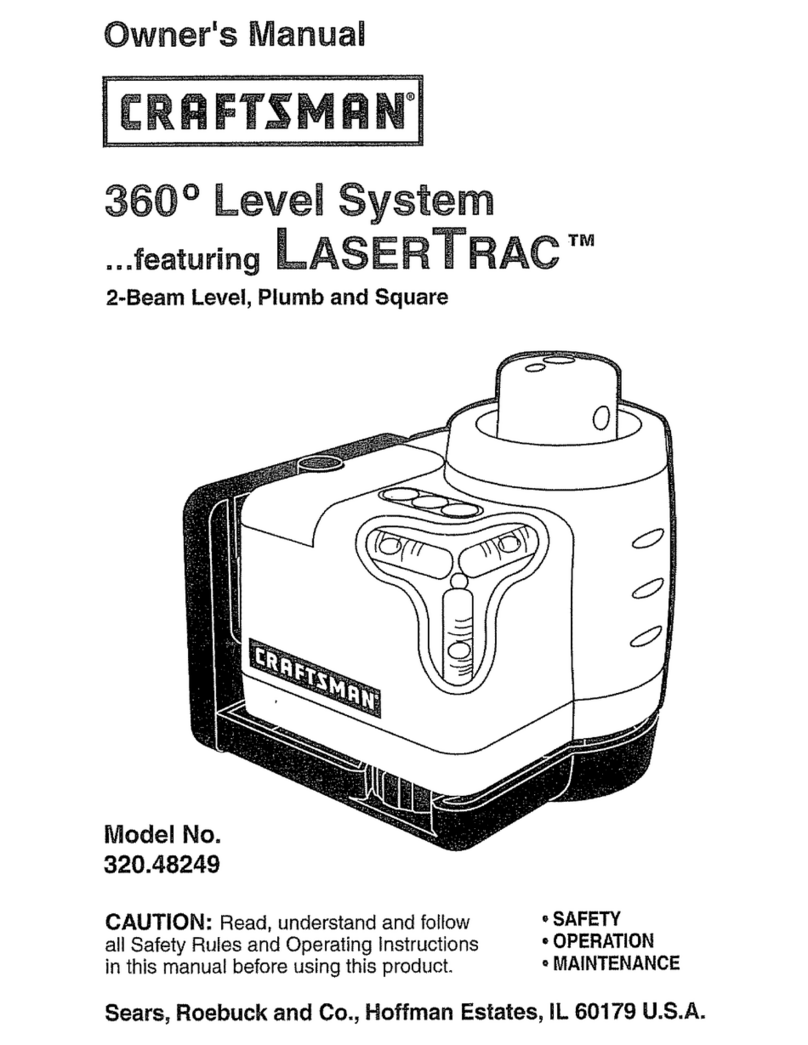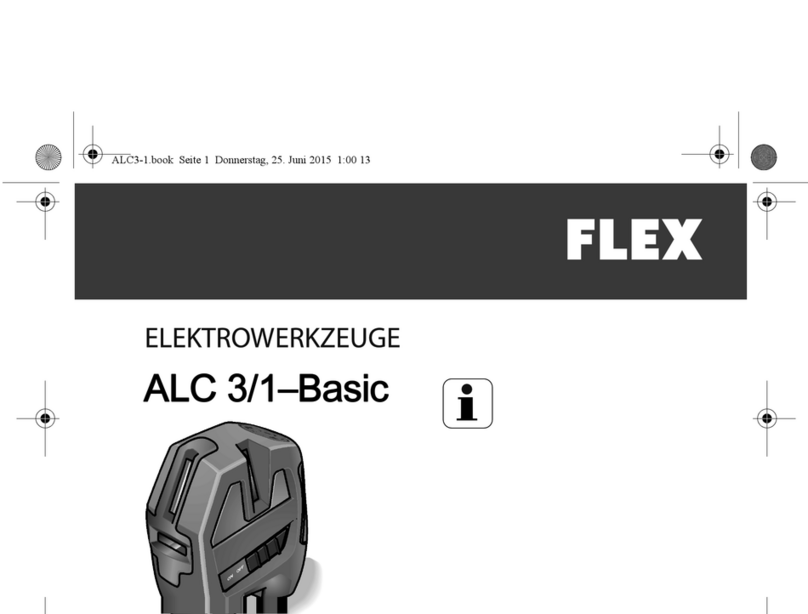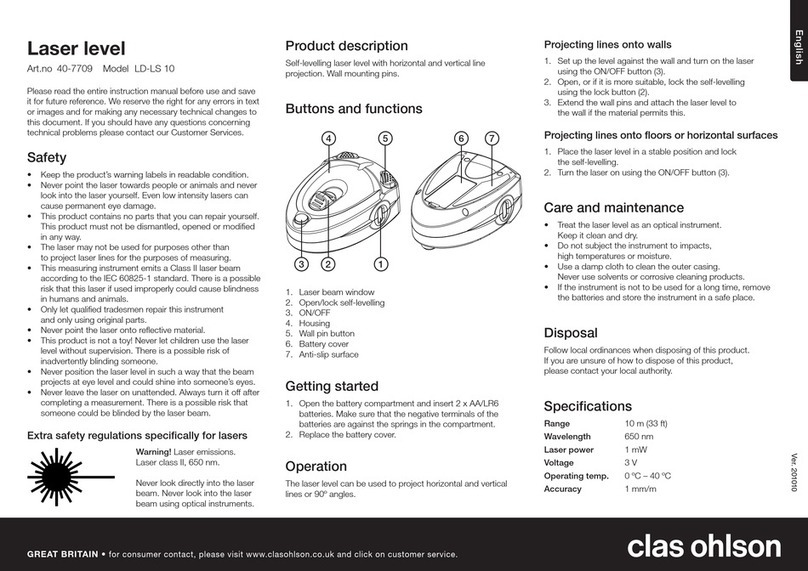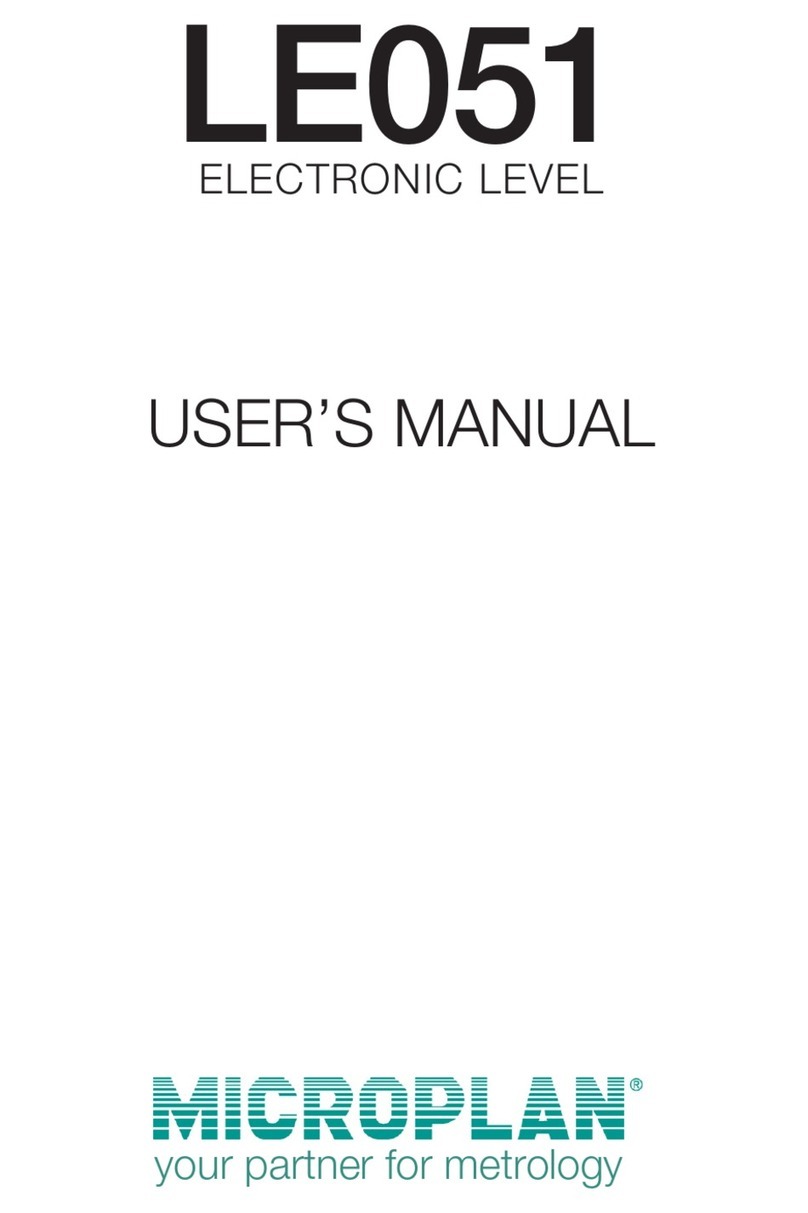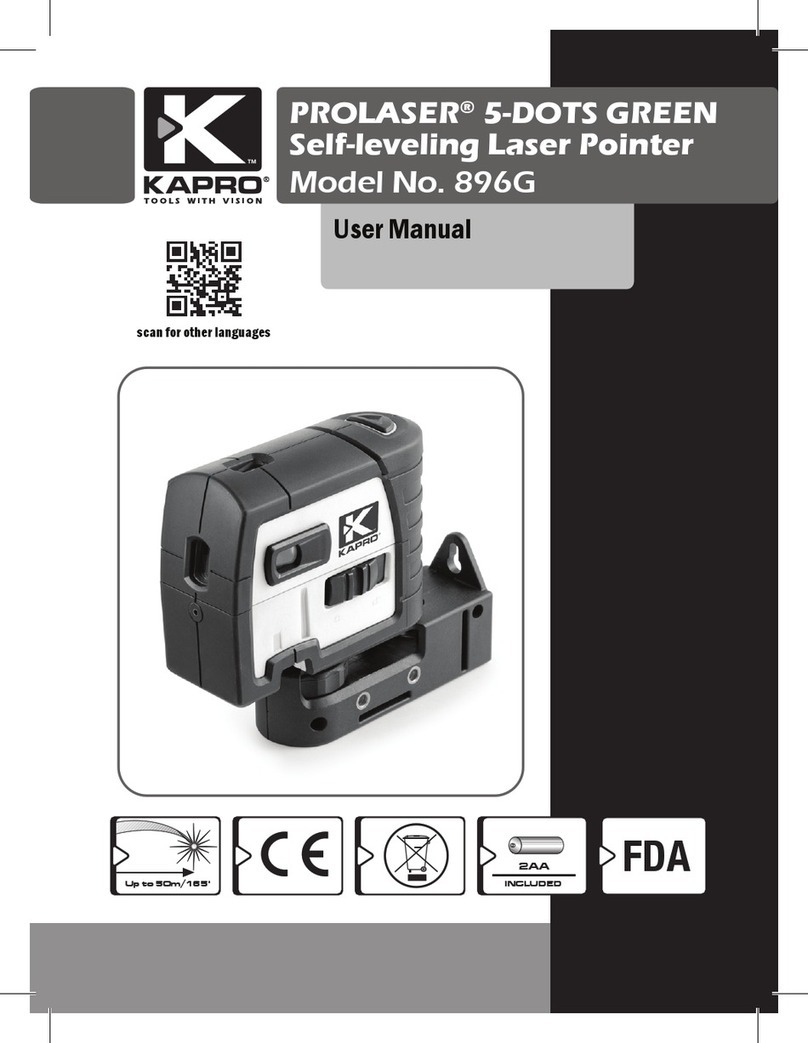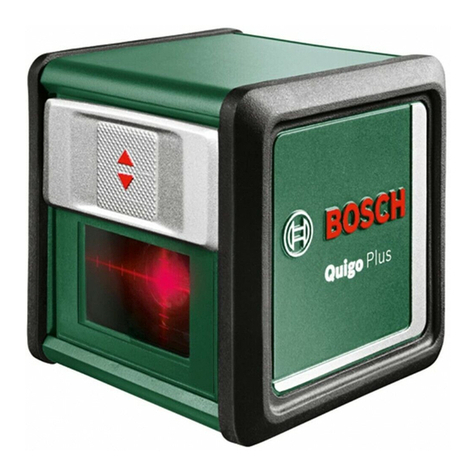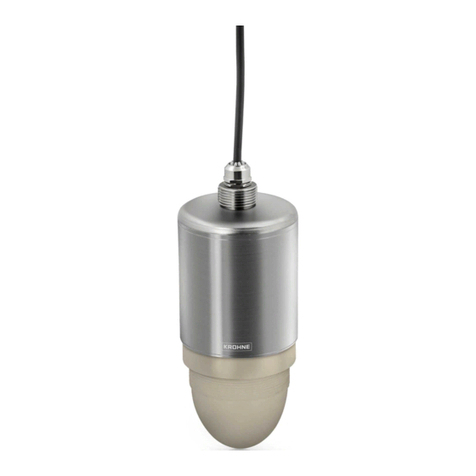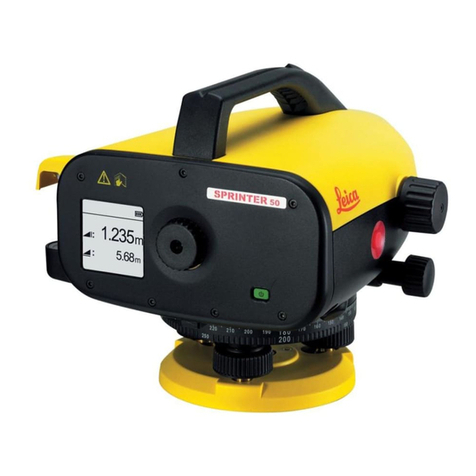E+H Micropilot S FMR 533 User manual

KA565F/00/a2/05.02
5200 9853
Ausgabe: 2
1
2
3
4
5
6
7
8
8
• Kreuzschlitzschraubendreher Größe 1
• Schlitzschraubendreher für M3 / M4
• Absteckwerkzeug für Antennenstecker (Best. Nr. 5200 7646)
• 6kant Innensteckschlüssel SW 2,5 / SW 4 / SW 5
• ggf. eine Pinzette
ENDRESS+HAUSERENDRESS+HAUSER
ENDRESS+HAUSER
MICROPILOT FMR
ENDRESS+HAUSER
MICROPILOT FMR
IP 65
Order Code:
Ser.-No.:
Order Code:
Ser.-No.:
Messbereich
Measuring range
Messbereich
Measuring range
U 16...36 V DC
4...20 mA
U 16...36 V DC
4...20 mA
max. 20 mmax. 20 m
Made in Germany MaulburgMade in Germany Maulburg
T >70°C :
At >85°C
T >70°C :
At >85°C
Anschlag-
schraube
Feststell-
schraube
Abdeckhaube
Frontplatte
Prozess-
anschluss
Bohrung für
Plombendraht
geschlossen
offen
Elektronik-
modul
Endress+Hauser Maulburg
Der Austausch erfordert folgende Werkzeuge:
Antennenkabel
9
Absteck-
werkzeug
Mulde
Für den Einsatz im eichpflichtigen Verkehr ist die Verplombung des Verriegelungsschalters vorgesehen. Über diesen Schalter kann der Zugriff auf die Elektronik
verhindert und die Einstellung des Gerätes verriegelt werden. In diesem Fall muss nach dem Öffnen der Plombe (notwendig beim Austausch von Ersatzteilen)
ein Eichbeamter den Micropilot bei der Inbetriebnahme der Messung erneut abnehmen und verplomben!
Es dürfen nur identische, originale E+H-Ersatzteile eingesetzt werden.
Das Gerät darf nur von Fachpersonal repariert und gewartet werden. Dabei sind die Gerätedokumentation, die einschlägigen Normen,
die gesetzlichen Vorschriften und die Zertifikate zu beachten!
01
2
01
2
Ex i-Geräte: Die Reparatur ist so durchzuführen, dass die Spannungsfestigkeit der Ex ia Stromkreise gegen Erde erhalten bleibt.
Bei Bedarf kann eine Prüfung mit 500 Veff über 60 s durchgeführt werden.
Vor der Demontage ist sicherzustellen, dass die Versorgungsspannung für das Gerät abgeschaltet ist.
Austausch der Parabolantenne / des Flansches am Micropilot S, FMR 533
Beim Antennentausch muss die Ersatzantenne dem Originaltyp entsprechen, es ist messtechnisch nicht erlaubt einen anderen Antennentyp zu montieren.
1
2
3
4
5
6
7
8
9
Vorbereitung zum Antennenwechsel:
Die Komponenten sind nun ausgebaut, das Gehäuse
kann vom Prozessanschluss abgehoben werden
(Beschreibung umseitig).
Der Einbau der Komponenten erfolgt in umgekehrter
Reihenfolge. Dabei ist besonders auf (9) Anschluss des
Antennenkabels zu achten.
Deckel zum Elektronikraum abschrauben (4 Umdrehungen)
Wenn vorhanden, ein Display durch Hochdrücken des Hakens aus der
Halterung lösen
Schraube der Abdeckhaube lösen und Haube abnehmen
Verriegelung an der Frontplatte öffnen, ggf. Plombe entfernen
Beide Widerhaken am Modulgehäuse leicht eindrücken und ...
... Frontplatte nach vorn abziehen
Versorgungsleitung, Signalleitung und Display abstecken
Die 2 Befestigungsschrauben des Elektronikmoduls lösen und
das Elektronikmodul aus dem Gehäuse ziehen
Das Antennenkabel mittels Werkzeug abstecken
Flansch/Antenne

Endress+Hauser Maulburg
KA565F/00/a2/05.02Austausch einer Parabolantenne am FMR 533
Austausch der Parabolantenne
Bei zertifizierten Geräten ist die Reparatur eines Gerätes zu dokumentieren!
Hierzu gehört die Angabe der Geräte-Seriennummer, Reparaturdatum, Art der Reparatur und ausführender Techniker
01
2
Nach Austausch einer Antenne oder der Elektronik ist in jedem Fall eine
Neukalibration der Füllstandmessung erforderlich (siehe Anhang).
Demontage der Parabolantenne / Anschraubflansch
11
12
13
13
14
14
10
IP 65
U16...36VDC
4...20mA
U 16...36 V DC
4...20 mA
max.20m
max. 20 m
T>
70°C :
At >85°C
T >70°C :
At >85°C
11
10
12
O-Ring 49.21 x 3.53 EPDM
(O-Ring Set 52005628)
Erdungsfeder
Flansch
Feststellschraube am Gehäuse etwa eine Umdrehung lösen
(Innensechskantschlüssel SW 4)
Anschlagschraube im Gehäuse ca. 4 - 5 Umdrehungen ausschrauben
(Innensechskantschlüssel SW 2,5)
Das Gehäuse mit drehenden Bewegungen vom Prozessanschluss abziehen
Achtung: Das Antennenkabel dabei nicht beschädigen
Der Parabolreflektor ist durch ein Mannloch im Behälter von der Antenne
abzubauen, dazu sind die 4 Schrauben zu lösen
Die Parabolantenne mit Antennenrohr und Antennenkabel bilden eine
Einheit und können nicht getrennt werden
Den Anschraubflansch vom Behälter lösen und mit dem Antennenrohr aus
dem Behälter ziehen
Durch Abschrauben der 4 Inbusschrauben (SW 5) kann ein
UNI-Flansch vom Antennenrohr getrennt werden
UNI-Flansch:
Ausrichtmarkierung
Antennenrohr
Zusammenbau
Der Zusammenbau und Einbau der Antenne erfolgt in umgekehrter Reihenfolge:
• UNI-Flansch: Anschraub-Flansch (14) montieren und Inbusschrauben
mit 10 Nm festziehen.
• Antennenrohr mit Flansch am Behälter so montieren, dass die
Ausrichtmarkierung zur Behälterwand zeigt
• Parabolreflektor durch ein Mannloch im Behälter am Antennenrohr mit
4 Inbusschrauben (SW 5) befestigen
• Den O-Ring am Antennenrohr vor dem Einsetzen mit etwas Silikonfett
einschmieren
• Gehäuse auf das Antennenrohr aufsetzen (12)
• Anschlagschraube (11) bis zum Anschlag einschrauben, dann 1/2 bis
1 Umdrehung wieder lösen
• Erdungsfeder so ausrichten, dass sie mit dem Antennenrohr eine leitende
Verbindung herstellt (Erdpotenzial zur Antenne)
• Elektronik und alle Module wieder einbauen, dabei auf klemmfreien Sitz der
Kabel achten
• Die Feststellschraube (10) fest anziehen
• Es ist zu beachten, dass ein Hinweisschild "elektrostatische Aufladung an der
Antenne vermeiden" mit einer Ringöse am Gehäuse angebracht ist
(siehe umseitig)
Parabolreflektor
Parabolantenne

Endress+Hauser Maulburg
KA565F/00/a2/05.02 Austausch einer Parabolantenne am FMR 533
Ausrichtung eines eingebauten Gerätes nach dem elektrischen Feld
Die Sendekeule hat immer ein elektrisches- und ein magnetisches Feld die 90° zueinander stehen.
Die Ausrichtmarkierung auf dem Einschraubstück oder dem Flansch kennzeichnet in gedachter horizontaler Verlängerung die Antenneneinkopplung und damit die
Polarisierung des elektrischen Feldes in der Sendekeule.
Durch Drehen des Einschraubstückes oder des Flansches (und damit der elektromagnetischen Felder) kann eine Optimierung der Messung erreicht werden.
Hierzu ist anhand der Hüllkurve das Echosignal zu maximieren (Hüllkurvendarstellung auf dem Anzeigemodul in der Bedienmatrix, Feld 09C).
Die Abbildungen zeigen die einbauabhängigen Ausrichtungen (die Planarantenne FMR 532 muss nicht ausgerichtet werden).
Diese Ausrichtungen entsprechen gemäß allgemeiner Erfahrungen dem Optimum. Jedoch kann bei besonderen Verhältnissen
auch eine andere Ausrichtung besser sein.
Ausrichtung im Bypass:
verlängerter Markierungspunkt
steht 90° zum Zulauf
(gilt auch für Hornantenne)
90°
Behälter
Bypass
Ausrichtung im
Schwallrohr:
Verlängerter
Markierungspunkt
in Richtung der
Schlitzreihe Behälter
Schwallrohr
90°
ENDRESS+HAUSER
MICROPILOTII
ENDRESS+HAUSER
MICROPILOTII
IP 65
IP 65
OrderCode:
Ser.-No.:
OrderCode:
Ser.-No.:
Messbereich
Measuringrange
Messbereich
Measuringrange
U16...36VDC
4...20mA
U16...36V DC
4...20mA
max.20m
max.20 m
MadeinGermany MaulburgMadeinGermany Maulburg
T>70°C:
At>85°C
T>70°C:
At>85°C
Ausrichtung im Behälter:
Markierung zur
Behälterwand
ausgerichtet
Auf der Deckfläche des Flansches (FMR 530/531) oder am
Hals (FMR 533) ist eine eingestempelte Ausrichtmarkierung II
Eine Mikrowellenmessung wird beeinträchtigt durch Inhomogenitäten,
Asymmetrien, Störreflexionen usw. des elektromagnetischen Feldes.
Die Skizze verdeutlicht, wie das angedeutete Feld durch Drehen
des Gerätes und der Antenne anders ausgerichtet werden kann.
Damit ist eine Optimierung der Sende-/Empfangsleistung möglich.
ideal
nicht optimal
23°

Endress+Hauser Maulburg
KA565F/00/a2/05.02Austausch einer Parabolantenne am FMR 533
Kalibration des Micropilot S FMR 533 nach Austausch einer Parabolantenne
Die gepaarte Zuordnung von Antenne / Elektronik und HF-Modul verbietet den Austausch einer einzelnen Baugruppe und es entfällt somit auch eine
spezif. Grundkalibration.
Ein Austausch einzelner Komponenten in einer Werkstatt zum Zweck der Fehleranalyse im Reparaturfall ist zwar erlaubt, aber der Einbau einer
"falschen" Baugruppe führt zu einem hohen Messfehler, der die Messwerte weit außerhalb der angegebenen Geräte-Spezifikationen liegen läßt.
Nach dem vorschriftsmäßigen Einbau des Gerätes in den Behälter ist dieses nach dem elektrischen Feld auszurichten (siehe Kapitel "Ausrichten eines
eingebauten Gerätes . . .") und neu zu parametrieren. Wenn von der ursprünglichen Kalibration alle Parameter gespeichert wurden (Upload),
so ist mit einem Download die gesamte Prozedur der Neukalibration eingespart.
Vorbereitung zur Füllstandskalibration
Gerät ist zusammengebaut
und am Behälter montiert
Es empfiehlt sich vor der Kalibration das Gerät mit einem
Reset auf die Werkseinstellungen rückzusetzen:
In der Diagnose-Ebene im Feld 0A3 die Zahl 333 eingeben.
Gegen unbeabsichtigtes Ändern der eingestellten Gerätedaten
sollte die Parametrierung verriegelt werden:
In der Diagnose-Ebene im Feld 0A4 eine Zahl <> 100 eingeben.
Für den Einsatz im eichpflichtigem Betrieb (nach OIML R85) muss über
den Eichschutzschalter der Zugriff auf die Elektronik verhindert werden.
Hierzu muss ein eichamtlicher Prüfer diesen Schalter plombieren.
Grundabgleich gemäß Betriebsanleitung durchführen.
Bitte den Unterschied zwischen Freifeldantenne und
Schwallrohrantenne beachten.
Voraussetzung für mm-Genauigkeit (für eichfähigen Betrieb),
ist ein Reset der Historie durchzuführen, Matrixfeld 009 = ja
(In der Diagnose-Ebene im Feld 0A3 die Zahl 555 eingeben)
Ende
mit einem Tank Side Monitor sind
weitere Kompensationen möglich
(z.B. Druck, Temperatur usw.)
Totalreset 7864
Die Indexkorrekturtabelle und die
Tabelle für "Automat. Mikrofaktor-
bestimmung" werden zurückgesetzt.
E =
F =
D =
L =
SD =
Nullpunkt (empty)
Einstellung in 005
Spanne (full)
Einstellung in 006
Distance (Abstand Flansch / Füllgut)
Anzeige in 0A5
Level (Füllstand)
Anzeige in 0A6
Safety distance (Sicherheitsabstand)
Einstellung in 015
SD
F
E
L
D
In der Gruppenauswahl "Einbautenabgleich" wenn nötig neue Peiltabelle
aufnehmen (nur bei mm-Genauigkeit)

Grund-
abgleich
Ausgang bei
Echoverlust
• Alarm
• Halten
• Rampe%/min
*
Medium Eigen-
schaften
• unbekannt
• < 1.9
• 1.9 ... 4
• 4 ... 10
• > 10
Messbedingungen
• Standard
• Oberfläche ruhig
• Oberfl. unruhig
• zusätz. Rührwerk
• schnelle Änderung
• Test: Filter aus
Verzögerung
0
Zeit bei Echo-
verlust
max. 4000 [s]
(s)
*
Abgleich leer
[ m ]
Abstand Flansch
zu min. Füllstand
Abgleich voll
[ m ]
Messspanne Rohr-
durchmesser
Innendurchmeser
Bypass/Schwallrohr
Distanz/Mess-
wert
•Distanz m
• Messwert m
Abgleichauswahl
(nicht bei ToFTool/
und Commuwin II)
Sicherheits-
einstellungen
Einbauten-
abgleich
Lineari-
sierung Linearisierung
• Linear [%]
Füllstand/
Restvolumen
• Füllstand TE
(Kundeneinheit)
• Restvolumen TE
(Kundeneinheit)
Rampe
% Span / min
Sicherheits-
abstand
ab Antennenspitze
oder Hornkante
im Sicherheits-
abstand
•Alarm
• Warnung
• Selbsthaltung
*
Überfüll-
sicherung
•standard
•WHG
Reset
Selbsthaltung
• nein
• ja
Status Dip Tab
• Tabelle ein
• Tabelle aus
erweiterter
Abgleich
Endwert Mess-
bereich [%]
Linearisierung
Tabellen Nr. Linearisierung
Füllstand [m]
Peiltabelle
Peiltabelle
Linearisierung
Volumen [%]
nächster Punkt:
• ja
• nein
Kundeneinheit
s. Tabelle
aktuelle
Ausblenddistanz
Ausblendung
• inaktiv
• aktiv
• löschen
starte Ausblendg.
aus
an
Echoqualität
[dB]
Integrationszeit
[s]
Füllhöhenkorrekt
[m]
wird zum gemess.
Füllstand addiert
Blockdistanz
[m]
•
Distanz prüfen
Distanz = ok
• zu klein
• manuell
Bereich Ausblend
Eingabe des ausbl.
Bereiches
00
01
03
04
05
0 1 2 3 4 5 6 7 8 9
Gruppen-
auswahl
Auswahl der Kundeneinheiten
0: %
1: litre
2: hl
3: m3
4: dm3
5: cm3
Micropilot S, FMR 53x Menüstruktur HART (Anzeigemodul)
• lösche Tabelle
Ausgang bei
Alarm xx.xx mA
Autokorrektur
• an
• aus
Korrektur
Rohrdurchmesser
• an
• aus
Ausgang b. Alarm
• MIN (3.6 mA)
• MAX (22 mA)
• Halten
*
Tank Gauging
• Peil Tabelle
• Autokorrektur
Endwert Mess-
bereich [%] Zylinder-
durchmesser [m]
Sprung zum
Matrixfeld 51
Tankgeometrie
• Klöpper-Deckel
• zylindr. liegend
• Flachdeckel
• Kugeltank
• Bypass
• Schwallrohr
Peiltabelle
• Ansicht
• manuell
• halbautomatisch
• Tabelle ein
• Tabelle aus
• lösche Tabelle
Handhab. Dip Tab
• Nächster Punkt
• Vorher. Punkt
• Punkt speicher
• Punkt löschen
• Neuer Punkt
• Punkt Auswahl
Messwert
00.000
12: ton
13: m
14: ft
15: mm
16: inch
17: none
Kommunikations-
adresse [0...15]
(wenn > 0 dann
Multidropfunktion,
Stromausgang auf 4 mA fixiert!)
aktueller Fehler letzter Fehler lösche letz. Fehler
•
beibehalten
• löschen
Rücksetzen
x
zur Codeeingabe
siehe Betriebsanl.
Ausgang
Anzeige
Diagnose
06
09
0A
Präambelanzahl
für HART [4...20]
Sprache zur Startseite
3...9999 Sekunden
Anwendungspara-
meter
•(V0H2-3-4)
nicht geändert
• geändert
Zust. eichfähig
• inaktiv
• aktiv positiv
• aktiv negativ
Anzeigeformat
• dezimal
• 1/16" (inch)
Anzeigetest
(nicht ToFTool und
Commuwin II)
• aus
• an [1s]
Trennungszeichen
•. (Punkt)
• , (Komma)
Darstellungsart
•09A
Hüllkurve
• Hüllkurve + FAC
• Hüllkurve +
Ausblendung
Kurve lesen 09B
• einzelne Kurve
• zyklisch
Nach-
komma-
stellen
Grenze Messwert
•aus
• an
fester Strom
•
an
aus
•fester Stromwert
4 mA
Ausgangsstrom
x.xx mA
Simulation
• Sim. aus
• Sim. Füllstand
• Sim. Volumen
• Sim. Strom Simulationswert
Kundeneinheit
s. Tabelle
Kundeneinheit
s. Tabelle
• zylindr. liegend
• manuell
• halbautomatisch
• Tabelle ein
0C Messstelle
tag No. Seriennummer
Protokoll +
Software Nr.
Anzeigeformat:
Vxx.yy.zz.prot
Software Nr.
Eichfähigkeit
Längeneinheit
• m
• ft
• mm
• inch
Download Mode
• nur Parameter
• Param.+Ausblen.
• Ausblendung
System
Parameter
• X
• X.X
• X.XX
• X.XXX
• X.XXXX
xx: HW-Version
yy: SW-Version
zz: SW-Revision
prot: Protokollname
Beisp: V01.01.00HART
Softwareversion 2.0 SM09F/00/05.02
Rücksprung zur
Gruppenauswahl
Rücksprung zur
Gruppenauswahl
Rücksprung zur
Gruppenauswahl
Rücksprung zur
Gruppenauswahl
Rücksprung zur
Gruppenauswahl
Rücksprung zur
Gruppenauswahl
Rücksprung zur
Gruppenauswahl
Rücksprung zur
Gruppenauswahl
Rücksprung zur
Gruppenauswahl
6: ft3
7: us gal
8: i gal
9: kg
10: t
11: lb
• English
• Deutsch
• Francais
• Espanol
• Italiano
• Nederl.
Sprung zum
Matrixfeld 008
008
• Füllstand
(m, ft, in)
• Restvolumen
(m, ft, in)
• erweiterte
Ausblendung
• Ausblendung
• allgemein
• zu gross
• Dist. unbekannt
09C
xx dB
100: Kundenmatrix
editierbar
200: Kunden- / Servicematrix lesbar
gemessene
Distanz [m] gemessener
Füllstand [m]
300: Kunden- / Servicematrix editierbar 33 998: WHG editierbar
33 999: Hardware Verriegelung
Freigabecode
Zur Servicematrix
• Anwenderspezif.
(s)0
*
*
= Einstellungwerte nur für WHG
• Zurück
Messwert [m]
Dip Wert [m]
bleiben x Messwert [m]
bleiben x
Dip Wert [m]
Historien-Reset

Info
Distance MAM filter length MAM filter border hysterese width
[mm]
env. avg.count
1; 8 ; 16
low pass filter
[s]
max. fill speed
[mm/s]
ZF average
an / aus
max. drain speed
[mm/s]
unfiltered dist.
raw
[mm]
Envelope envelope
statistics
mapping adder
envelope
smoothing
mapping scan
rate
[dB]
edge detect. mode
front; behind;
middle of echo
first echo factor
[dB]
tank bottom det.
aus; an
HF module
• µP II.1
• µP II.2
• µPIII.1
• µPIII.2
zero distance
[mm]
antenna type
rod; horn; dish;
planar
plausible funct.
aus; an
D/A adjust 4 mA
not PROFIBUS PA
D/A adjust
20 mA
not PROFIBUS PA
plausible funct.
max. delta
plausible funct.
max. delta
[mm]
plausible funct.
upper area
[mm]
display version
VU331 XX
calc. cycle time
[ms]
software version
application
parameter vers.
application
HW fail counter
inactive length
[mm]
debug index 1 debug index 2 debug value error state
algorithms
state
algorithms
total length
[mm]
max. measuring
distance
[m]
ampl. reference
pulse
[dB]
pos. reference
pulse
[mm]
min. amplitude
tank bot. detec.
[dB]
max. level
tank bot. detec.
[mm]
FEF threshold
[dB]
FEF at near
distance
[dB]
FEF distance
far
[mm]
FEF distance
near
[mm]
FEF edge
[dB]
present FEF
[dB]
fill / drain speed
[mm / s]
mapping
average
FAC adder
[dB]
FAC scan rate range factory
map
[m]
pres. micro fact.
temp. of electr.
[C]
fact. map. valid
an; aus; löschen
edge parameter
[dB]
cust. map valid
not active; active
trig. fail count
fact. map valid
not active; active
module frequen.
[MHz]
envelope
energy
[dB]
present edge
parameter
[dB]
Mapping
Edge
First echo
Tank bottom
detection
Module
Antenna
table
present
amplitude
amplitude over
mapping
amplitude
over FAC
unfiltered
distance
present
edge parameter
present FEF
first echo factor device name
FMR53x
unfiltered dist.
fine
[mm]
order code
unfiltered dist.
phase
[mm]
0D
0D0
0D1
0D2
0D3
0D4
0D5
0D6
0D7
0D8
0D9
0DC
0DD
0DF back to
function group
back to
function group
back to
function group
back to
function group
back to
function group
back to
function group
back to
function group
back to
function group
back to
function group
back to
function group
back to
function group
back to
function groupl
0 1 2 3 4 5 6 7 8 9
Micropilot S, service matrix HART (display module)
System 1
System 2
Debug
0D00
0D10
0D20
0D30
0D40
0D50
0D60
0D70
0D80
0DC0
0DD0
0DF0
0D21
0D01 0D02 0D03
0D11 0D12
Service
SM09F/00/05.02
software version 2.0
Algorithm 1 IC default value quali calc. PD anal. phase state
aus; an
present PD
[mm]
IC save begin
[mm]
IC save end
[mm]
IC state
Algorithm 2 fine envelope
variante
aut. base gain
aus; an
base gain val. automatic gain
aus; an
far distance gain
[mm]
near dist. gain
[mm]
pres. gian value
distance gain
[mm]
gain settings
IC pres. value IC used value
0DA
0DB
back to
function group
back to
function group
back to
function groupl
0D90
0DA0
0DB0
0DA1
0D91 0D92

KA565F/00/a2/05.02
5200 9853
release: 2
1
2
3
4
5
6
7
8
8
• Philips screw driver size 1
• flat screwdriver for M3 / M4
• unplug tool for antenna plug (order No. 5200 7646)
• Allen wrench AF 2.5 / AF 4 / AF 5
• eventually tweezers
ENDRESS+HAUSERENDRESS+HAUSER
ENDRESS+HAUSER
MICROPILOT FMR
ENDRESS+HAUSER
MICROPILOT FMR
IP 65
Order Code:
Ser.-No.:
Order Code:
Ser.-No.:
Messbereich
Measuring range
Messbereich
Measuring range
U 16...36 V DC
4...20 mA
U 16...36 V DC
4...20 mA
max. 20 mmax. 20 m
Made in Germany MaulburgMade in Germany Maulburg
T >70°C :
At >85°C
T >70°C :
At >85°C
stop
screw
set
screw
cover
front panel
process
connection
bore for
seal wire
locked
open
electronic
module
antenna cable
Endress+Hauser Maulburg
The following tools are required for the exchange:
9
unplug
tool
groove
Exchange of the parabolic antenna / flange for Micropilot S, FMR 533
In case of an antenna exchange, the replacement antenna must be identical with the original type. It is technically not allowed to install another antenna type.
Only identical, original E+H spare parts may be used.
The instrument may only be maintained and repaired by qualified personnel. The device documentation, applicable standards and legal
requirements as well as any certificates have to be observed!
01
2
01
2
Ex i-devices: The repair has to be performed such that the voltage isolation of the Ex ia circuits against ground is maintained..
If required, a test can be performed with 500 Veff over a time of 60 s.
The custody locking switch can be sealed for custody transfer applications. Access to the electronics can be revented by means of a custody locking switch
that locks the device settings. In this case, after any breaking of the seal (required for exchange of parts), the Micropilot must again be tested and sealed
by an official at commissioning!
Before disassembly, ensure that the operating voltage for the instrument has been switched off.
Preparation for antenna exchange:
The components are now disassembled, the housing
can be lifted off the process connection.
(description on next page)
Assembly is done in reverse order.
Special attention has to be payed to the connection of
the antenna cable (9).
Unscrew lid from electronic compartment (4 turns)
If applicable, push up hook and remove display from holder
Loosen screw at cover and remove cover
Open locking at front panel and eventually remove seal
Slightly push in both hooks at the module housing and ...
... pull off front panel
Unplug supply voltage, signal cable and display
Loosen 2 mounting screws at electronic module and pull
module out of the housing
Unplug antenna cable with unplug tool
1
2
3
4
5
6
7
8
9
parabolic antenna

Endress+Hauser Maulburg
KA565F/00/a2/05.02Exchange of a parabolic antenna / flange for FMR 533
Exchange of the parabolic antenna / flange
Any repair of a certified device has to be documented!
This includes stating the device serial number, date of repair, type of repair and name of the repair technician.
01
2
After an exchange of antenna, the instrument has to be enabled to measure
by means of a basic calibration (see description next page)
Disassembly of parabolic antenna / flange
11
12
13
13
14
14
10
IP 65
U16...36VDC
4...20mA
U 16...36 V DC
4...20 mA
max.20m
max. 20 m
T>
70°C:
At >85°C
T >70°C :
At >85°C
11
10
12
O-ring 49.21 x 3.53 EPDM
(gasket set 52005628)
grounding spring
flange
Loosen set screw at housing approximately 1 turn (Allen wrench AF 4)
Unscrew stop screw at hosuing approx. 4 - 5 turns (Allen wrench AF 2.5)
Pull housing off process connection
Attention: do not damage antenna cable!
Take off the antenna through a manhole in the tank by loosening the 4 screws
Loosen flange from tank and pull out of the tank together with the
antenna pipe.
The flange can be separated from the antenna pipe by removing
the 4 Allen screws (AF 5)
UNI-flange:
The parabolic antenna with antenna pipe and antenna cable are one complete
assembly that cannot be taken apart
Assembly
The assembly and installation has to be done in reverse order:
• UNI-flange: mount flange (14) and tighten Allen screws with 10 Nm
• Mount antenna pipe with flange on tank, and align t
•
• Lubricate the O-ring between process connection and housing with some silicon
grease before mounting
• Mount housing on antenna pipe (12)
• Tighten stop screw (11) until stop, then loosen ½ to 1 turn
• Adjust the grounding spring to make a conductive connection with the antenna
pipe (ground potential to antenna)
•
• Mount completely assembled instrument in tank
• Tighten set screw (10) firmly
• The warning sign “Avoid electrostatic charge at the antenna” must be attached to
the housing with a key ring
he alignment marker to the
tank wall (see next page)
Mount parabolic reflector through manhole in tank with 4 Allen screws (AF 5) to
the antenna pipe
Re-install electronics and all modules, make sure that the cables are not pinched
alignment marker
antenna pipe
parabolic reflector
parabolic antenna

Endress+Hauser Maulburg
KA565F/00/a2/05.02 Exchange of a parabolic antenna for FMR 533/ flange
Alignment of an installed instrument according to the electrical field
The beam pattern always consists of an electrical and a magnetical field, oriented to each other with a 90° offset.
The alignment marker on the threaded connection or flange marks the virtual horizontal extension of the antenna coupling, thus the polarization of the electrical field
in the beam pattern.
The measurement can be optimized by rotating the threaded boss or flange (and therefore the electromagnetic fields). For this purpose, the echo signal in the
envelope curve has to be maximized (envelope curve display on display unit in operating matrix field 09C).
The figures show the installation specific alignments.The planar antenna FMR 532 does not have to be aligned.
These alignments are optimum based on general experience. However, under certain circumstances another
alignment can be better.
Alignment in bypass:
marker point is offset to T’s
by 90° (also applies
to horn antenna)
90°
tank
bypass
Alignment in
stilling well:
marker points
toward slots
tank
stilling well
90°
ENDRESS+HAUSER
MICROPILOTII
ENDRESS+HAUSER
MICROPILOTII
IP 65
IP 65
OrderCode:
Ser.-No.:
OrderCode:
Ser.-No.:
Messbereich
Measuringrange
Messbereich
Measuringrange
U16...36VDC
4...20mA
U16...36 V DC
4...20mA
max.20m
max.20 m
MadeinGermany MaulburgMadeinGermany Maulburg
T>
70°C:
At>85°C
T >70°C:
At>85°C
Alignment in tank:
marker oriented
towards
tank wall
An imprinted alignment marker can be found on the flange
surface (FMR 530/531) or on the neck (FMR 533)
II
A microwave measurement can be negatively influenced by the electrical field
being non-homogenious, non-symmetrical or subject to interference reflections etc.
The sketch shows how the indicated field can be oriented differently by
turning the instrument and the antenna.
This allows an optimization of the received signal.
ideal
not optimum
23°

Endress+Hauser Maulburg
KA565F/00/a2/05.02Exchange of a parabolic antenna / flange for FMR 533
Calibration of the Micropilot S
Antenna / electronics and HF module are paired and can therefore not be exchanged separately. Thus, a specific basic calibration does not apply.
An exchange of individual components in a workshop for an error analysis in case of a repair is possible, however, installation of a “wrong” assembly
leads to significant measuring errors considerably outside the specifications.
After the instrument has been installed according to the instructions, it has to be aligned for its electrical field (see chapter "Alignment of installed instrument")
and to be newly configured.
In case all parameters have been stored from the original calibration (upload), a download saves the complete new calibration process.
Preparation for a level calibration
FMR 533 after exchange of parabolic antenna
Instrument is assembled
and mounted on tank
It is recommended to reset the instrument to the factory settings
before the calibration:
enter 333 in field 0A3 of the diagnostics level.
The configuration should be locked against unwanted changes:
enter a value < > 100 in field 0A4 in the diagnostics level.
For operation calibrated to legal standards (according to OIML R85),
access to the electronics must be locked with the lock switch, which has
to be sealed by an official.
Perform basic setup according to manual.
Observe the difference between free field antenna
and stilling well antenna.
A requirement for mm-accuracy (for calibration to legal standards)
is the reset of the history:
enter 555 in field 0A3 of the diagnostics level.
End
when using a Tank Side Monitor, further
compensation is possible
(i.e. pressure, temperature, etc.)
total reset for HART: 7864
the index correction table and the
table for automatic micro-factor
determination are reset.
E =
F =
D =
L =
SD =
zero point (empty)
set in 005
span (full)
set in 006
distance (distance flange / product)
displayed in 0A5
level
displayed in 0A6
safety distance
set in 015
SD
F
E
L
D
Include new dip table in the group selection "mounting calibration”

basic
setup
output echo loss
• alarm
• hold
• ramp%/min
*
medium property
• unknown
• < 1.9
• 1.9 ... 4
• 4 ... 10
• > 10
process condition
• standard
• calm surface
• turbulent surface
• additional agitator
• fast change
• test: no filter
delay time
0
in case of
echo loss
max. 4000 [s]
(s)
*
empty calibration
[ m / feet]
distance flange to
min. level
full calibration
[ m / feet ]
span pipe
diameter
inside diameter
bypass/stilling well
distance /
measured value
•distance m/ft
• meas. value m/ft
selection
(not for ToFTool/
and Commuwin II)
safety
settings
mounting
calibration
lineari-
sation linearisation
• linear [%]
level / ullage
• level CU
• ullage CU
Ramp
% span / min
safety distance
from tip of antenna
or lower edge of
horn
in safety distance
•alarm
• warning
• self holding
*
overspill
protection
•standard
•WHG
reset
self holding
• no
• yes
extended
calibration
max. scale [%]
History reset
linearisation
table No. linearisation
level [m]
dip table
linearisation
volume [%]
next point:
• yes
•no
customet unit
see table
actual
mapping distance
mapping
• inactive
• active
• delete
start mapping
off
on
echo quality
[dB]
output damping
[s]
offset [m]
will be added to the
measured level
block. distance
[m]
check distance
• d
istance = ok
• too small
• manual
mapping range
input of mapping
range
00
01
03
04
05
0 1 2 3 4 5 6 7 8 9
group
selection
selection of customer units
0: %
1: liter
2: hl
3: m3
4: dm3
5: cm3
Micropilot S, FMR 53x menu structure HART (display module)
• clear table
output on alarm
xx.xx mA
auto correction
• on
• off
correction
pipe diameter
• on
• off
output on alarm
• MIN (3.6 mA)
• MAX (22 mA)
• hold
*
tank gauging
• dip table
• auto correction
max. scale [%] diameter vessel
[m]
jump to
matrix field 51
tank shape
• dome ceiling
• horizontal cyl.
• vertical cylinder
• sphere
• bypass
• stilling well
dip table
• view
• manual
• semi-automatic
• table on
• table off
• clear table
dip table handl.
• next point
• previous point
• store point
• delete point
• new point
• edit point
measured value
00.000
12: ton
13: m
14: ft
15: mm
16: inch
17: none
communication
address [0...15]
(if > 0 then multidrop
function, current
output fixed at 4 mA!)
present error previous error clear last error
• keep
• erase
reset
x
for reset code
see manual
output
display
diagnostics
06
09
0A
No. of preambles
for HART [4...20]
language back to home
3...9999 seconds
application para-
meter
•(V0H2-3-4)
not changed
• changed
custody mode
• inactive
• active positive
• active negative
display format
• decimal
• 1/16" (inch)
display test
(not for ToFTool
and Commuwin II)
• off
• on [1s]
sep. character
•. (period)
• , (comma)
plot settings
•09A
envelope curve
• env. curve + FAC
• env. curve+ map.
record curve 09B
• single curve
• cyclic
no. of
decimals
low output limit
• off
• on
fixed current
• off
• on fixed current
4 mA
output current
x.xx mA
simulation
• sim. off
• sim. level
• sim. volume
• sim. current simulation value
customer unit
see table
customet unit
see table
• horizontal cyl.
• manual
• semi-automatic
• table on
0C tag No. serial number
protocol +
software No.
display format:
Vxx.yy.zz.prot
software No.
custody transfer
distance unit
• m
• ft
• mm
• inch
download mode
• parameters only
• param.+ map.
• mapping only
system
parameters
• X
• X.X
• X.XX
• X.XXX
• X.XXXX
xx: HW-version
yy: SW-version
zz: SW-revision
prot: protocol name
i.e.: V01.01.00HART
software version 2.0 SM09F/00/05.02
return to
group selection
return to
group selection
return to
group selection
return to
group selection
return to
group selection
return to
group selection
return to
group selection
return to
group selection
return to
group selection
6: ft3
7: us gal
8: i gal
9: kg
10: t
11: lb
• English
• Deutsch
• Francais
• Espanol
• Italiano
• Nederl.
jump to
matrix field 008
008
• level
(m, ft, in)
• ullage
(m, ft, in)
• extended map.
• mapping
• common
• too big
• unknown
09C
xx dB
100: edit cust.matrix
200: read customer /
service matrix
measured
distance [m] measured
level [m]
300: edit service matrix
33 998: edit WHG
33 999: hardware lock
unlock parameter
to service matrix
• user specific
(s)0
*
*
= settings only for WHG
• return
meas.value [m]
dip value [m]
keep x meas.value [m]
keep x
dip value [m]
dip table dip table status
• table on
• table off

info
distance MAM filter length MAM filter border hysterese width
[mm]
env. avg.count
1; 8 ; 16
low pass filter
[s]
echo lost up
[mm/s]
ZF average
an / aus
echo lost down
[mm/s]
unfiltered dist.
raw
[mm]
envelope envelope
statistics
mapping adder
envelope
smoothing
mapping scan
rate
[dB]
edge detect. mode
front; behind;
middle of echo
first echo factor
[dB]
tank bottom det.
off; on
HF module
• µP II.1
• µP II.2
• µPIII.1
• µPIII.2
zero distance
[mm]
antenna type
rod; horn; dish;
planar
plausible funct.
off; on
D/A adjust 4 mA
not PROFIBUS PA
D/A adjust
20 mA
not PROFIBUS PA
plausible funct.
max. delta
plausible funct.
max. delta
[mm]
plausible funct.
upper area
[mm]
display version
VU331 XX
calc. cycle time
[ms]
software version
application
parameter vers.
application
HW fail counter
inactive length
[mm]
debug index 1 debug index 2 debug value error state
algorithms
state
algorithms
total length
[mm]
max. measuring
distance
[m]
ampl. reference
pulse
[dB]
pos. reference
pulse
[mm]
min. amplitude
tank bot. detec.
[dB]
max. level
tank bot. detec.
[mm]
FEF threshold
[dB]
FEF at near
distance
[dB]
FEF distance
far
[mm]
FEF distance
near
[mm]
FEF edge
[dB]
present FEF
[dB]
fill / drain speed
[mm / s]
mapping
average
FAC adder
[dB]
FAC scan rate range factory
map
[m]
pres. micro fact.
temp. of electron.
[C]
fact. map. valid
off; on; erase
edge parameter
[dB]
cust. map valid
not active; active
trig. fail count
fact. map valid
not active; active
module frequen.
[MHz]
envelope
energy
[dB]
present edge
parameter
[dB]
mapping
edge
first echo
tank bottom
detection
module
antenna
table
present
amplitude
amplitude over
mapping
amplitude
over FAC
unfiltered
distance
present
edge parameter
present FEF
first echo factor device name
FMR53x
unfiltered dist.
fine
[mm]
order code
unfiltered dist.
phase
[mm]
0D
0D0
0D1
0D2
0D3
0D4
0D5
0D6
0D7
0D8
0D9
0DC
0DD
0DF back to
function group
back to
function group
back to
function group
back to
function group
back to
function group
back to
function group
back to
function group
back to
function group
back to
function group
back to
function group
back to
function group
back to
function groupl
0 1 2 3 4 5 6 7 8 9
Micropilot S, service matrix HART (display module)
system 1
system 2
debug
0D00
0D10
0D20
0D30
0D40
0D50
0D60
0D70
0D80
0DC0
0DD0
0DF0
0D21
0D01 0D02 0D03
0D11 0D12
service
SM09F/00/05.02
software version 2.0
algorithm 1 IC default value quali calc. PD analogue phase
state
off; on
present PD
[mm]
IC save begin
[mm]
IC save end
[mm]
IC state
algorithm 2 fine envelope
variante
aut. base gain
off; on
base gain val. automatic gain
off; on
far distance gain
[mm]
near dist. gain
[mm]
pres. gain value
distance gain
[mm]
gain settings
IC pres. value IC used value
0DA
0DB
back to
function group
back to
function group
back to
function groupl
0D90
0DA0
0DB0
0DA1
0D91 0D92
This manual suits for next models
1
Table of contents
Languages:
